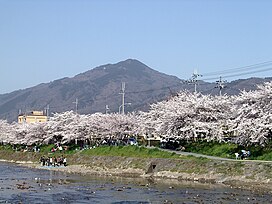
Back جبل هيه Arabic جبل هيه ARZ Monte Hiei AST Hiey dağı AZ Mont Hiei Catalan Hiei-zan (bukid sa Hapon, lat 35,06, long 135,83) CEB Hiei Czech Hiei-zan German Monte Hiei Spanish Hiei mendia EU
This article needs additional citations for verification. (November 2011) |
| Mount Hiei | |
|---|---|
| 比叡山 | |
 The view from Kyoto with Cherry blossoms (April 2005) | |
| Highest point | |
| Elevation | 848.1 m (2,782 ft) |
| Listing | List of mountains and hills of Japan by height |
| Coordinates | 35°4′0″N 135°50′18″E / 35.06667°N 135.83833°E |
| Geography | |
 | |
| Location | Honshū, Shiga Prefecture, Japan |
| Topo map(s) | Geographical Survey Institute 25000:1 京都東北部, 50000:1 京都及大阪 |


Mount Hiei (比叡山, Hiei-zan) is a mountain to the northeast of Kyoto, lying on the border between the Kyoto and Shiga Prefectures, Japan.
The temple of Enryaku-ji, the first outpost of the Japanese Tendai (Chin. Tiantai) sect of Buddhism, was founded atop Mount Hiei by Saichō in 788 and rapidly grew into a sprawling complex of temples and buildings that were roughly divided into three areas:
- The Saitō (西塔, "West Pagoda") area near the summit, and technically in Kyoto Prefecture.
- The Tōdō (東塔, "East Pagoda") area, also near the summit, where Enryaku-ji Temple was first founded, and located just within Shiga Prefecture.
- The Yokawa (横川, "Along the river") area near the northernmost end of Mount Hiei. Due to its remoteness, as a temple complex it experienced periods of revival and decline, starting with Ennin, later revived by Ryōgen and made famous by the scholar-monk Genshin.[1]
Due to its position north-east of the ancient capital of Kyoto, it was thought in ancient geomancy practices to be a protective bulwark against negative influences on the capital,[2] which along with the rise of the Tendai sect in Heian period Japan (8th - 12th centuries) meant that the mountain and the temple complex were politically powerful and influential. Later schools of Buddhism in Japan were almost entirely founded by ex-monks of the Tendai sect, such as Hōnen, Nichiren, Dōgen and Shinran, who all studied at the temple before leaving Mount Hiei to start their own practices.
The temple complex was razed by Oda Nobunaga in 1571 to quell the rising power of Tendai's warrior monks (sōhei),[3] but it was rebuilt and remains the Tendai headquarters to this day.
The 19th-century Japanese ironclad Hiei was named after this mountain, as was the more famous World War II-era battleship Hiei, the latter having initially been built as a battlecruiser.
- ^ Rhodes, Robert F.; Payne, Richard K. (2017). Genshin's Ōjōyōshū and the Construction of Pure Land Discourse in Heian Japan (Pure Land Buddhist Studies). University of Hawaii Press. ISBN 978-0824872489.
- ^ Groner, Paul (2000). Saicho: The Establishment of the Japanese Tendai School. University of Hawaii Press. pp. 17–37. ISBN 0824823710.
- ^ Sansom, George (1961). A History of Japan 1334–1615. Stanford: Stanford University Press. pp. 284. ISBN 0804705259.